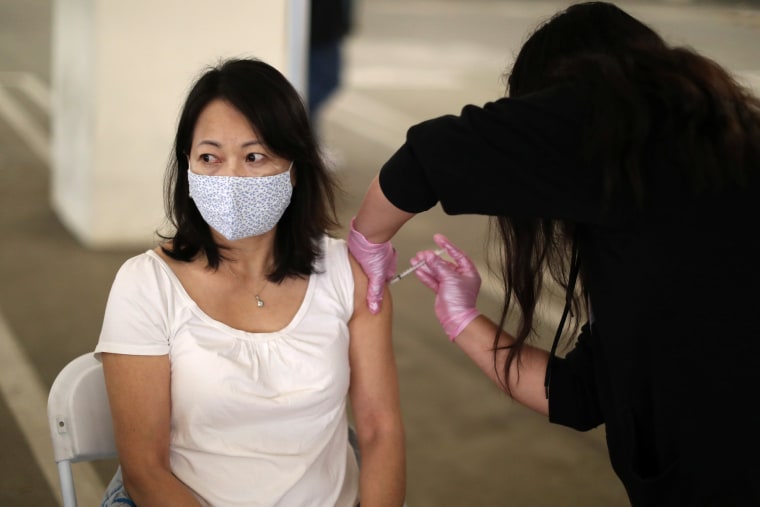When Covid-19 vaccines became available in Los Angeles mid-January, leaders at the Chinatown Service Center knew they had to coordinate an extensive outreach campaign to help thousands of poor, monolingual Chinese elders overcome a host of access barriers.
After installing a walk-in vaccination site, the staff held Zoom meetings, made door-to-door visits to residences for older people and put out ads in ethnic media to encourage people to show up. As an incentive, they’ve given out gift cards to the popular Chinese grocery chain 99 Ranch Market. The group also hired dozens of high school and college students from the neighborhood to provide language support to older people, translating paperwork and educational materials.
Since March, Chinatown Service Center has administered about 60,000 doses. Today, more than 70 percent of Asians in California have received at least one shot. Very few elders and local residents still stop by the clinic, which now serves mostly overseas Asian tourists, undocumented immigrants and people from nearby Latino enclaves.
But to reach this point, the whole community had to mobilize.
“If people are looking at these numbers and saying, ‘Asians are just easier, more compliant, more willing to get vaccinated,’ that’s just not true,” Jack Cheng, the center’s director of operations, told NBC Asian America. “Most of our seniors had no resources to do that. It has to be the strong work of community-based organizations.”
In recent months, Asians have become the most vaccinated racial group in more than half of the country, according to Bloomberg’s weekly tracker, which compiles demographic data from each state to analyze racial vaccination gaps. In many states, Asian Americans are getting jabbed at a higher rate than their share of the population. In New York City, for example, 77 percent of Asian American adults are fully vaccinated — more than 20 percent higher than the rate for white adults.
But the aggregate figures obscure sharp disparities among ethnic groups as well as the relentless, multipronged efforts from local nonprofit organizations to ensure their communities are not left out of an uneven vaccine distribution system.
Such has been the case in Philadelphia, where more than 90 percent of Asian Americans are at least partially vaccinated.
From February to May, South Philadelphia’s Southeast Asian and Black enclaves became “vaccine deserts” that suffered from a severe supply shortage, said Thoai Nguyen, executive director of Southeast Asian Mutual Assistance Association Coalition. Data from early spring showed that nearly half of the city’s allocated doses went to people who lived outside Philadelphia.
“The rollout process was steeped in racism,” he said, noting the city didn’t set up any vaccination sites within walking distance to Southeast Asian elders, many of whom lacked the language skills to take public transportation. “This whole year has been an uphill battle, from Asian Americans being blamed for the virus, being beaten up on the streets, to being deprived of vaccines in our own communities.”
In March, Nguyen’s organization partnered with Jefferson University Hospitals to open up a health clinic to immunize South Philadelphians. During the shortage, he worked with community health centers and pharmacies to secure doses while fighting the city for more equitable distribution. The group eventually provided more than 1,000 weekly vaccinations to residents.
In states like Mississippi, where Asians make up just 1 percent of the population, local groups have focused their outreach efforts at established cultural institutions.
Organizers with Boat People SOS, a nonprofit group that serves Mississippi’s roughly 10,000 Vietnamese refugees and immigrants, have been signing people up for appointments at churches, temples and nail salons. Over the past year, the group also held various Covid-19 workshops where medical experts explained how the doses worked.
Today, more than two-thirds of Asians in the state are vaccinated.
In North Carolina, where three in four Asian Americans have received at least one shot, community leaders say a lack of in-language resources made many public health services inaccessible to refugees, many of whom are illiterate in their native languages.
“The system is not designed for refugee and immigrant communities,” said Liana Adrong, executive director of the Montagnard Dega Association, a direct services organization that serves Greensboro’s Montagnard refugees. “We always have to walk an extra mile.”
Over the past few months, the group focused on immunizing the city’s Cambodian, Bhutanese and Burmese refugees at several pop-up clinics. The outreach campaign, carried out in a dozen languages, was relatively seamless: Organizers already had the contact information for hundreds of residents who signed up for a Covid-19 food bank last year. Altogether, the staff contacted more than 500 people, some 80 percent of whom have since received their shots.
The city, Androng said, should be providing more interpreters and in-person translation services so small nonprofit organizations are not overextended.
“We want support for the work we’re doing, and we want investments that are made in a culturally relevant way,” she said. “Some places might see translation needs as installing Google Translate on a website. But that’s not the point.”
Follow NBC Asian America on Facebook, Twitter and Instagram.
